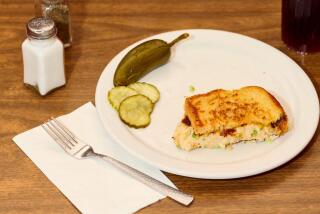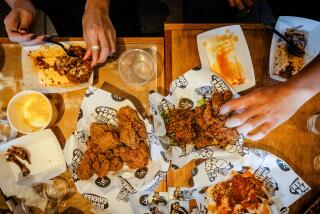Even at a ripe old age, citrus center breeds designer fruit
UC Riverside’s living citrus museum, which has 400 acres of trees, has attracted a cult following.
There was the nurseryman from France who came to the United States only to admire its unusual and succulent fruit. A local restaurateur, looking for new flavors for his entrees, nibbled on a variety of citrus blossoms.
Then there was the obsessed tangerine fan -- a gourmet grocer from Texas who wanted his picture taken next to the Seedless Kishu mandarin tree.
“That was a little strange,” said Tracy Kahn, a UC Riverside scientist who watches over the trees.
More than 1,000 members of the citrus family tree thrive in the Citrus Experiment Station, which celebrated its 100th anniversary on Wednesday. Generations of researchers here have developed and bred dozens of unique tasty fruits.
UC scientists established the Citrus Experiment Station in 1907 as a research center to support Southern California’s growing citrus industry and the center ultimately became the seedling from which UC Riverside sprouted in 1954.
Even with the mushrooming growth of new homes and shopping centers that now surrounds the university, UC Riverside’s citrus groves remain among the most diverse in the world.
During tours -- yes, the citrus station does draw in the curious -- visitors learn that lemons weren’t always small and cute. Long before grocers began stocking the fist-sized variety popular today, citrus growers fumbled with its ancestor, a lumpy 5-pound fruit the size of a Nerf football.
Growers in India are believed to have produced what is now considered the modern lemon about AD 100, after decades of crossing it with smaller citrus varieties.
In modern times, UC Riverside scientists have developed some best-selling fruits, including the Oroblanco grapefruit-pummelo hybrid, with its surprisingly sweet taste, and the tangy Gold Nugget mandarin.
But many of the university’s contributions have been more utilitarian, such as finding ways to eliminate bothersome bugs without pesticides.
The 400-acre station is now called the Citrus Research Center and Agricultural Experiment Station to reflect its expanded mission, which now includes research on asparagus and other vegetables.
The university runs a state-of-the-art bug lab, where entomologists are using genetics to combat the glassy-winged sharpshooter, responsible for transmitting Pierce’s disease, which kills grapevines and threatens California wineries. At the museum, a 25-acre parcel planted with the 1,000 citrus varieties -- two trees of each -- Kahn regularly entertains international citrus gurus.
Kahn has also played host to local chefs using the groves for inspiration.
The tiny caviar-like fruit of purple-skinned Australian Finger Limes makes a good garnish; the Buddha’s Hand, a fingered citron that looks like a miniature yellow octopus, makes an unusual centerpiece.
Escorting visitors through the rows of trees, Kahn sometimes pulls out a knife and treats guests to tasty Moro blood oranges and seedless mandarins fresh off the tree. But visitors beware, one lick of another fruit -- the citrange -- leaves a taste you remember for a week, and not because it’s sweet; it’s more like sickly rotten.
Despite the station’s expanded goals, citrus breeders haven’t let up on their quest to develop sweeter, hardier fruit. The university released three more seedless tangerine varieties to growers in 2002: Shasta Gold, Tahoe Gold and Yosemite Gold.
Meanwhile, the newly released Tango tangerine could become one of the most widely grown.
*
More to Read
Eat your way across L.A.
Get our weekly Tasting Notes newsletter for reviews, news and more.
You may occasionally receive promotional content from the Los Angeles Times.






